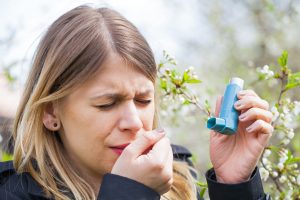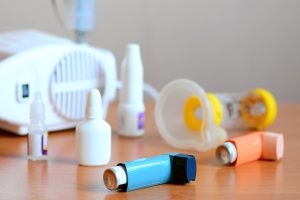Medical Equipment Calibration | Inhalation of an allergenic substance, a viral or chemical particle, or even a physical event that causes psychological effects are all factors that may contribute to an asthma attack. For sufferers of this disease, it is imperative that each patient know the triggers that affect them; to avoid future contact and improve their asthma management.
The elements that can trigger an asthma attack vary from person to person. They can also evolve from being harmless to dangerous in the same patient. In this article, we shall be looking in-depth at the common substances and situations that may cause an asthma attack.
Allergens: Primary Agents / Substances
Primary agents of allergens, responsible for asthma, are present in many sufferers immediate environment. There are three main types:

Seasonal allergens are often responsible for allergic rhinitis or allergic conjunctivitis; with the common substance being seasonal pollens at peak concentrations and Hay Fever. Generally, it is in the spring and summer that these allergens are most present.
Allergens present all year round: cockroaches, domestic animals (cats, dogs, hamsters, rabbits, etc.), microscopic animals present in dust and of course the mites are all capable of carrying substances/particles that cause asthma attacks. In addition to this children’s soft toys and even the carpet may hold dust for many years; unless they are cleaned regularly.
Food Allergens: For twenty years, food allergies have been steadily rising in populations. While this phenomenon is important in adults, children are the primary victims. Besides the infamous peanut, potentially allergenic foods are hard to follow unless you have been professionally tested.
Beware Of Chemical Irritants And Pollution!
Some irritants can promote the onset of asthma but also increase the frequency of seizures. Among these substances are external and domestic pollutants:
- External pollution: The risk of asthma attacks, bronchitis and other respiratory symptoms is higher in areas where individuals are subjected to high air pollution. The common cause being products of combustion, such as vehicle pollution and industrial chimney smoke; that emit ozone, nitrogen oxide, and sulfur dioxide. Pollution not only increase the risk of seizures in patients with asthma but it could also play a role in the development of asthma and other allergic manifestations.
- Passive smoking: In young children, passive smoking increases the risk of developing asthma, and the compounds of cigarette smoke can sometimes cause seizures. It is best not to smoke at all, but refraining from smoking inside your home or car, and always ensuring the area is ventilated to restrict others breathing in “secondhand” smoke is the next best thing.
- Indoor pollutants: Domestic pollution is just as dangerous to people living with asthma, with the common agents being cleaning chemicals, sprays, and disinfectants, furniture lacquers, paints, and glue. It is, therefore, critical to ventilate your home regularly to prevent a build up of the allergens; especially in bedrooms and preferably at night. Occupational exposure to flours, certain chemicals or metals can also lead to seizures.
- Gastroesophageal reflux: The abnormal reflux of stomach acid into the oesophagus can increase the risk of hyper bronchial activity causing coughing or asthma attacks.
- Changes in weather conditions: Cold air and fog may have an irritating effect on the bronchi and thus promote seizures. More surprisingly, thunderstorms have been recorded to increase the number of fungal spores in the air, as a result of violent swirling winds and thus the number of seizures.
Regarding passive smoking, deleterious effects occur as early as pregnancy. A pregnant woman exposed to cigarette smoke puts tremendous risk to her baby; including delayed fetal maturation, decreased birth weight. Concerning the appearance of asthma, little evidence exists between in utero exposure and the appearance of early asthma.

Physical Effort
Asthma attacks that occur during physical exercise or a few minutes after it stops are widespread among younger people with asthma. Unfortunately, It is sometimes difficult to distinguish it from “normal” shortness of breath. Ensuring that the individual has their medication in such situations to relieve the mild symptoms of an asthma attack is incredibly important. Equally, people living with asthma must not exclude themselves from sports and recreational activities; as regular exercise is extremely beneficial for overall health and well-being.
Stress and Strong Emotions
Strong emotions can trigger increased rhythm of breathing which may cause bronchial contraction and seizures. Heightened states of emotion would also affect the nervous control of the bronchial calibre or immune function concerning infections. Thus, it is not uncommon to see seizures occur during birthdays of asthmatic children, too “excited” by the event. Stress, excitement, pain, anxiety are all factors that trigger a crisis.
Furthermore, the control of the disease is often harder to treat for asthmatics suffering from psychological disorders. In addition to the symptoms being more severe and requiring regular hospitalisation and need for heavier treatments, these people are also more likely not to follow their treatment correctly.
Other Triggers
- Respiratory Infections: an asthmatic child is sensitive to infections of the respiratory tract. Developing asthma is more often than not manifested by repeated bronchitis.
- Aspirin: Allergy to aspirin affects adult asthmatics more than children. But very often this reaction occurs while skin tests are negative.
- Hormonal Factors: As the menstrual cycle approaches, some women experience more asthma attacks. Premenstrual asthma results in an increase in the severity of symptoms.
In most cases, several factors interact, and these combinations affect asthmatics in different proportions. Each asthmatic has to recognize the factors behind their seizures, helped by possible allergic skin tests, and to learn how to avoid them.
 Forest Medical Equipment Calibration
Forest Medical Equipment Calibration
Spirometry is breathing or ‘lung function’ test. It’s one of the most common tests people with asthma or people who are being tested for asthma, are given. Your GP or asthma nurse will ask you to take a deep breath and then breathe out as fast as you can and for as long as you can through a mouthpiece linked to a ‘Spirometer.’ You will have to blow a few times so your GP or asthma nurse can get an accurate result.
As with all medical equipment, Spirometers need thorough and comprehensive testing on a regular basis. Failure to adequately test a Spirometer puts it at risk of failure or of false readings being displayed from the equipment; which can have disastrous results.
We undertake thorough Medical Equipment Calibration to fully test your machines and ensure that they are safe and suitable for use.

